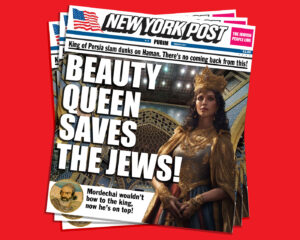Those Other Holidays
WE'RE NOT SURE WHAT THESE HOLIDAYS ARE EITHER.
At JewBelong, we focus mostly on The Big Four Holidays (Passover, Rosh Hashanah, Yom Kippur and Hanukkah) and Shabbat. There are a lot more Jewish holidays than that, actually, 46 if you include all of the fast days and other stuff. If we took a deep dive into all of them, you’d be here all day, and maybe part of tomorrow. And nobody wants that, right? So, the overviews below are enough to give anyone who needs it a jumpstart, ’cause TBH, if you’re already celebrating Sukkot or Lag BaOmer, you probably know more about these holidays than we do.

Sukkot
Dine under the stars. Actually, under the stars and plastic fruit.

Hint: Sukkot always starts five days after Yom Kippur. Sukkot is known as the Harvest Festival, kind of like Jewish Thanksgiving. It lasts for seven days. The holiday is named after the temporary huts that the Israelites lived in while they wandered through the desert for 40 years. Many people celebrate Sukkot by building their own huts, called sukkahs, and hanging out and eating their meals in them. Some families even sleep in their sukkah, which can be like a big family sleepover. Two traditions of Sukkot are waving the lulov and etrog, which has to do with joy, fertility and rain, and decorating the sukkah with fruit and paper chains.


Shemini Atzeret
The bridge between Sukkot and Simchat Torah. Yup, that's all we got.

Shemini Atzeret is the day after the last day of Sukkot (Shemini means eighth in Hebrew and some people consider this the eighth day of Sukkot) and the day before Simchat Torah. It comes with its own prayers and traditions, but no one can really explain what the holiday is about, mostly because there isn’t a clear translation for the word Atzeret. Let us know if you figure it out.
Simchat Torah
You finish the Torah and then start all over again. You dance too so the whole thing doesn't seem futile.

Simchat Torah, Hebrew for Rejoicing with the Torah, celebrates the end of the yearlong cycle of weekly Torah readings. It’s a cool holiday because if you go to a synagogue, you can actually see the rabbi or whoever read the end of the Torah and then basically wind the whole thing to the other side to start from the beginning again. Some synagogues unscroll the entire Torah, with people standing next to one another holding the top and bottom of the parchment really carefully so it doesn’t rip, which looks super cool. Simchat Torah is a happy holiday with lots of singing and dancing and eating.


Purim
Beauty queen saves the Jews! Like a NY Post headline but true.

Purim is another one of those they-tried-to-kill-us-and-failed holidays. It commemorates the story of smokin’ hot Queen Esther, who won a beauty contest, but the prize was to marry the King of Persia, who was kind of an idiot. So, bummer. The king decided to follow the advice of his advisor, Haman, to kill all the Jews, of course, not realizing that that included his wife. Then Esther had to convince the King not to go through with his plan. Lucky for us, she convinced him. Phew. And instead Haman got hung in the gallows that he built for the Jews. Moral of the story: do not f*#king mess with the Jews. The celebrations often include Purim Schpiels which are plays which retell the story but in all kinds of original ways (like with Star Wars themes and stuff like that). And lots of dress up! And eating hamentashen and drinking till you’re shit-faced. SRSLY, they say you are supposed to drink until you don’t know the difference between Haman, the bad guy, and Mordechai, the good guy, in the Purim story.
Shavuot
So, the Torah is kind of a big deal. This is when we got it.

Shavuot is the ultimate all-nighter. It’s a harvest festival but is mostly known for that time when the Jews received the Torah at Mount Sinai. The tradition is to stay up all night and study Torah, which is surprisingly awesome. We know, you’re like, dude, what’s so great about that? But remember back in college when that crazy studying 3:00am slightly euphoric feeling set in and you suddenly and inexplicitly feel at one with everyone else in the library? It’s like that but better, ’cause there’s no test or deadline. There’s also a tradition of eating dairy foods like blintzes and cheesecake (and Lactaid).


Tisha B’Av
When you read about what this holiday memorializes, fasting just won't seem so tough.

Tisha B’Av is not the day to ask for that promotion or make that big bet on a new business idea. It’s a holiday (if you can call it that) that commemorates really shitty days for the Jews. Basically, a lot of bad things have happened to the Jews and Tisha B’Av is a day to help us remember. It commemorates the destruction of the two temples in Jerusalem, the expulsion of Jews from England in 1290, and again from France in 1306, from Spain in 1492, the Nazis approval for “The Final Solution,” in August of 1941, etc. We commemorate the day with fasting and sadness.
Tu B'Shvat
People of the book our ass - try people of the plow!

Tu B’Shvat is essentially Jewish Arbor Day. Oh, glad you straightened that out…ummm…what’s Arbor Day, you ask? Okay, we had to check too. Arbor Day is a holiday to celebrate trees. And why do we also need a Jewish one too? The answer is that in Israel trees are an extra big-f*#king deal because most of Israel was a desert and most of the trees were literally planted one by one. So no, the forests in Israel didn’t just appear from like God or whatever. In biblical days, Tu B’Shvat was helpful because it marked the day that Jewish farmers should plant or start counting days for a harvest of a certain crop. But, now it’s mostly an ecological-awareness day, when people eat fruit and plant more of those badly needed trees.


Lag BaOmer and Counting the Omer
Spiritual renewal for 49 days? Burning Man only lasts nine.

The omer is the 49-day period that starts on the second night of Passover, when the Israelites left Egypt, and ends with Shavuot, when they received the Torah. The tradition is to “count the omer,” meaning to literally count the days in anticipation of receiving the Torah. It’s meant to be a time of spiritual renewal and for people who count to think about their personal relationship to Torah/Judaism. There are plenty of rules that go along with the counting, including ones about what to do in case you forgot to count one night. There are even omer counting apps to help! Counting the omer is supposed to be a somber time which is kind of puzzling, cause how are you supposed to stay somber for 49 days? During this time, you are supposed to stay away from big celebrations. Like, you can’t get married during that period, or go to a concert, or even get a haircut…wait, can you get a bad haircut? Now, just in case this was all getting to be too much sadness for you, on the 33rd day of counting the omer, there is a break called Lag BaOmer. It’s a minor holiday that no one really knows the origin of, maybe someone just got fed up with all the doom and gloom! On Lag BaOmer, you can take a break from being sad and get married or do something fun. But then you need to go back to the somber feeling for the last 16 days until you are finished counting the omer.
Leil Selichot
It's like foreplay before the High Holidays.

Leil Selichot is kind of like pre-gaming for the High Holidays. Selichot are prayers of forgiveness that are said during the week leading up to Rosh Hashanah and Yom Kippur. Some observant Jews say the Selichot prayers every day for a week leading up to Rosh Hashanah. For others, the Shabbat before Rosh Hashanah is their one-shot deal.


Tu B’Av
Swipe right already. Let's do this.

If you’ve been waiting for your partner to pop the question, it just might happen. Tu B’Av is like a Jewish Valentine’s Day. Awww. It’s a sweet day to celebrate love and romance. Back in the olden days, it was a 24-hour period for unmarried women to find a husband (without help from J-Date or Tinder). More recently, it’s become a good-luck day for dates and weddings. And even more romantic, it always falls on a full moon. Sweet!
Yom HaZikaron
Of Blessed Memory.

Yom HaZikaron is Israel’s Memorial Day, a Remembrance Day for Israeli military who lost their lives fighting for the State of Israel. Sadly, since Israel is basically surrounded by enemies, there are a lot of soldiers to remember. Unlike American Memorial Day, this day is all about showing respect for those who served. Schools and most businesses are closed and there are dramatic memorial siren blasts in the morning and the afternoon. The day is serious stuff. The importance of the Israeli army is part of everyday life there, and this holiday focuses on the idea that there wouldn’t be independence without the soldiers who fought and died for it. The fun starts the next day though…with Yom Ha’atzmaut, which is Israel’s Independence Day. (Painting by the amazingly talented Natan Elkanovich,)


Yom Ha'atzmaut
Israeli Independence Day. When we celebrate Israel and their insanely attractive population.

Yom Ha’atzmaut, Israel’s Independence Day, comes the day after Yom HaZikaron and it’s a lot like American 4th of July with parties to celebrate independence. And, TBH, Israel’s very existence often seems like a bit of a miracle, so celebrating her independence is not something that people take for granted.
Yom HaShoah
Never forget.

The biblical word Shoah means destruction and is the Hebrew word for Holocaust which was the mass murder of six million Jews under the German Nazi regime from 1933-1945. Yom is the Hebrew word for day. So, Yom Hashoah is Holocaust Remembrance Day. It’s a day to remember a terrible catastrophe, but the day is also meant to celebrate those who resisted, like the brave souls who fought for freedom during events like the Warsaw Ghetto Uprising. In Israel on Yom HaShoah at 10:00am, they blow sirens all over the entire country, and everyone stops what they are doing. Even cars and buses stop on the highway and everyone takes a full two minutes to remember what happened when the world went crazy with hate.
